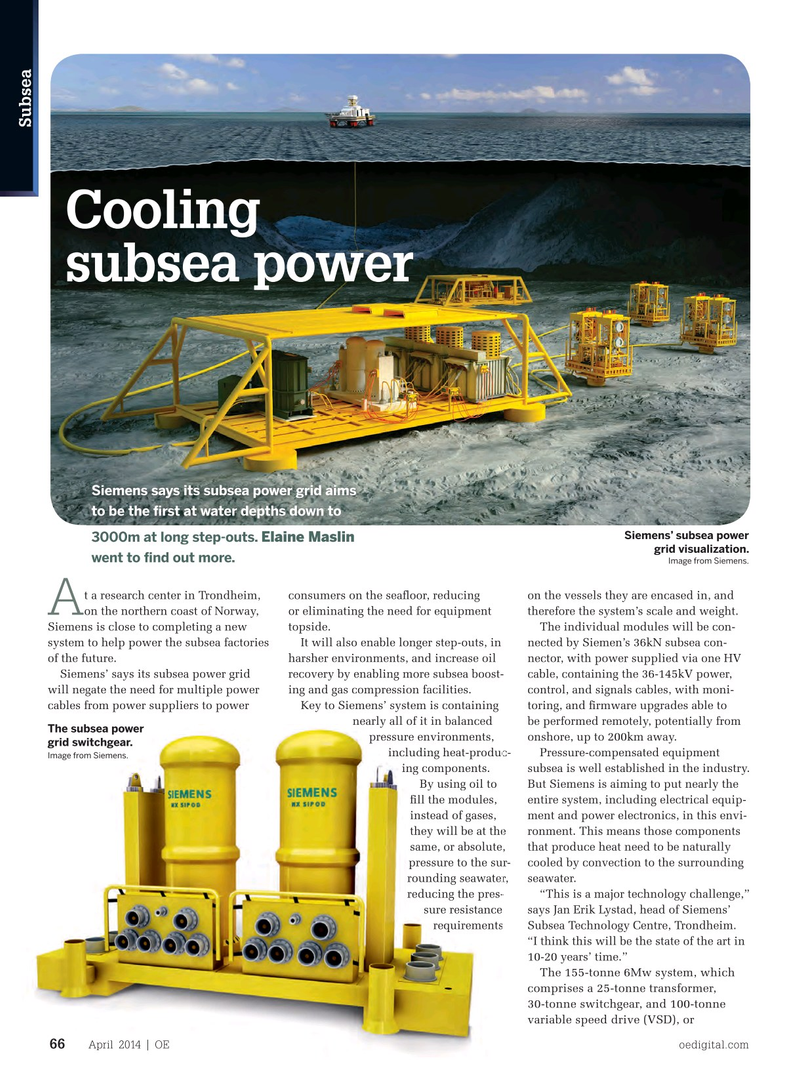
Page 64: of Offshore Engineer Magazine (Apr/May 2014)
Read this page in Pdf, Flash or Html5 edition of Apr/May 2014 Offshore Engineer Magazine
Subsea
Cooling subsea power
Siemens says its subsea power grid aims to be the ? rst at water depths down to
Siemens’ subsea power
Elaine Maslin 3000m at long step-outs. grid visualization. went to ? nd out more.
Image from Siemens.
t a research center in Trondheim, consumers on the sea? oor, reducing on the vessels they are encased in, and
A on the northern coast of Norway, or eliminating the need for equipment therefore the system’s scale and weight.
Siemens is close to completing a new topside. The individual modules will be con- system to help power the subsea factories It will also enable longer step-outs, in nected by Siemen’s 36kN subsea con- of the future. harsher environments, and increase oil nector, with power supplied via one HV
Siemens’ says its subsea power grid recovery by enabling more subsea boost- cable, containing the 36-145kV power, will negate the need for multiple power ing and gas compression facilities. control, and signals cables, with moni- cables from power suppliers to power Key to Siemens’ system is containing toring, and ? rmware upgrades able to nearly all of it in balanced nearly all of it in balanced be performed remotely, potentially from
The subsea power pressure environments, pressure environments, onshore, up to 200km away. grid switchgear. including heat-produc- including heat-produc- Pressure-compensated equipment
Image from Siemens.
ing components. ing components. subsea is well established in the industry.
By using oil to By using oil to But Siemens is aiming to put nearly the ? ll the modules, ? ll the modules, entire system, including electrical equip- instead of gases, instead of gases, ment and power electronics, in this envi- they will be at the they will be at the ronment. This means those components same, or absolute, same, or absolute, that produce heat need to be naturally pressure to the sur- pressure to the sur- cooled by convection to the surrounding rounding seawater, rounding seawater, seawater. reducing the pres- reducing the pres- “This is a major technology challenge,” sure resistance sure resistance says Jan Erik Lystad, head of Siemens’ requirements requirements Subsea Technology Centre, Trondheim. “I think this will be the state of the art in 10-20 years’ time.”
The 155-tonne 6Mw system, which comprises a 25-tonne transformer, 30-tonne switchgear, and 100-tonne variable speed drive (VSD), or
April 2014 | OE April 2014 | OE oedigital.com 6666 000_OE0414_Susbea-2.indd 66 3/22/14 8:42 PM

 63
63

 65
65